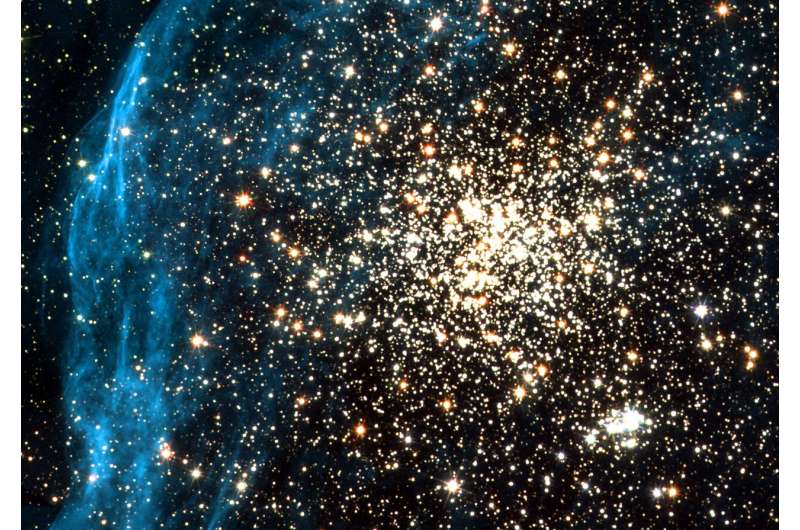November 22, 2021 report
Astronomers detect a black hole in NGC 1850

An international team of astronomers reports the detection of a black hole in a globular cluster known as NGC 1850. The newly found black hole is about 11 times more massive than the sun and turns out to be a part of a binary system. The finding was detailed in a paper published November 12 on arXiv.org.
Given that black holes cannot be directly observed, proving their existence is challenging. The strongest evidence for black holes comes from binary systems in which a visible star can be shown to be orbiting a massive but unseen companion. Therefore, astronomers use these systems to directly uncover the presence of a black hole by studying the motion of a visible object orbiting around it.
To date, only a few direct dynamical detections of non-interacting black holes have been made in star clusters due to observational limitations. Moreover, no direct dynamical detection of a black hole in a young massive cluster has been reported so far. Finding such objects could be crucial in advancing our knowledge regarding the initial mass function and the early dynamical evolution of black holes in high-density environments.
Now, a group of astronomers led by Sara Saracino of Liverpool John Moores University, U.K., reports the first dynamical detection of a black hole with a companion in a globular cluster (GC). The object, designated NGC 1850 BH1, was found in NGC 1850—it is a young (about 100 million years old) and massive (with a mass of around 100,000 solar masses) GC in the Large Magellanic Cloud (LMC). The discovery is part of a systematic search for stellar-mass black holes in young massive stellar clusters in the LMC by exploiting multi-epoch MUSE (Multi Unit Spectroscopic Explorer) observations taken at ESO's Very Large Telescope (VLT), through the monitoring of radial velocity variations.
According to the study, the newly found binary consists of a black hole with a mass of approximately 11.1 solar masses and a main-sequence turn-off star (MSTO) about 4.9 times more massive than the sun. It is a semi-detached system, with a short period of 5.04 days and orbital inclination at a level of 38 degrees.
The researchers assume that the system will likely experience a Roche-Lobe overflow, as soon as the companion star evolves out of the main-sequence. They predict a stable mass transfer and significant X-ray emission, generally leading to a widening of the binary.
"Mass transfer will likely end when most of the hydrogen envelope of the donor star has either been transferred to the companion or been lost from the system, leaving a helium star core. If so, it will likely experience another phase of mass transfer (and X-ray emission) when the star burns helium in shell, ending up as a black hole + white dwarf system," the astronomers explained.
Summing up the results, the authors of the paper noted that their discovery may be the starting point in the construction of the black hole initial mass function. Moreover, their study supports the search for the complete, dynamically detectable population of black holes.
More information: S. Saracino et al, A black hole detected in the young massive LMC cluster NGC 1850. arXiv:2111.06506v1 [astro-ph.GA], arxiv.org/abs/2111.06506
© 2021 Science X Network



















